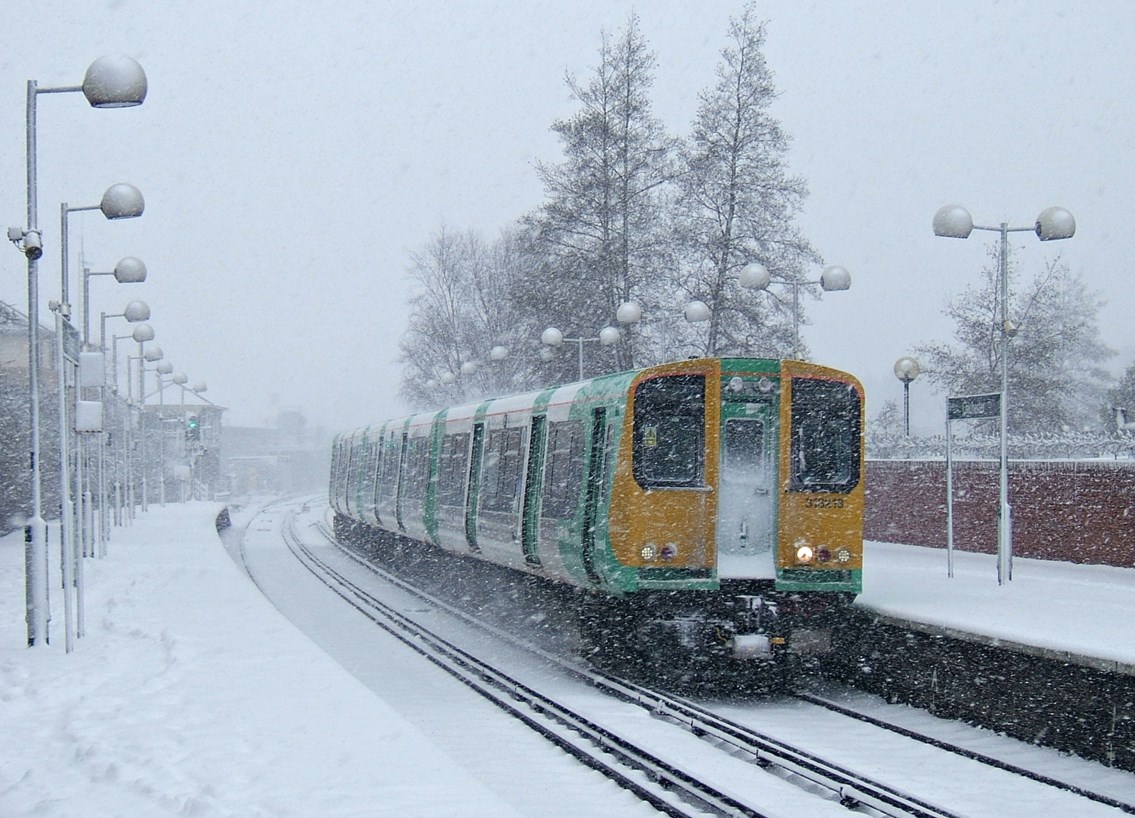Monday 14 Jan 2019
Snow and ice treatment trains ready to keep passengers moving during winter weather
- Region & Route:
- Southern
Network Rail’s fleet of snow and ice treatment trains are ready to keep passengers moving this winter and minimise disruption.
Govia Thameslink Railway (GTR) also has robust plans in place, including running ghost trains overnight to help keep tracks clear, plus its new fleet of Thameslink trains which feature a special snow mode to help braking.
Unlike some other parts of the country, trains on the South East Route, which includes Sussex and south London, draw their power from the conductor rail. But if ice forms on the surface of the rail, it interrupts the flow of electricity and trains can’t draw power to move.
That’s why Network Rail has a fleet of 12 treatment trains which will travel the equivalent of six times around the world – that’s 161,296 miles – scraping ice off the conductor rail using metal brushes and spraying thousands of litres of
anti-icing fluid to prevent the formation of ice.
John Halsall, Network Rail’s managing director in the south east, said: “We’ve been preparing for winter for months and are working 24/7 to keep passengers moving.
“Our snow and ice treatment trains are ready to travel around 160,000 miles laying anti-icing gel to stop ice forming on the third rail, while we’ve also improved our extreme weather forecasting so we can stay one step ahead of Mother Nature.”
As well as freezing the conductor rail, snow and ice can also freeze or jam points so trains cannot switch tracks safely, while couplers which join trains together can freeze, which causes problems joining or separating carriages.
GTR began preparing for wintry weather in the autumn, with de-icing equipment distributed, stocks checked, and staff briefed on procedures. The operator not only runs overnight ghost trains to help keep tracks clear and improved new Thameslink trains, but it has previously made modifications to other classes of train to increase their resilience.
Alex Foulds, Business Improvement Director and Deputy Chief Operating Officer at GTR, said: “We can never guarantee to keep all our services running if the weather takes a very bad turn for the worse, but with Network Rail we are well prepared and will do all we can to keep passenger disruption to a minimum.”
On top of this, Network Rail has:
- Fitted points which are prone to freezing with heaters and NASA-grade insulation.
- Installed conductor rail heating in some areas.
- This year, Network Rail is trialling a more effective anti-icer fluid on the Sheerness line, which contains more of the active ingredient that stops ice forming.
- Adjusted its extreme weather forecasting processes to better predict ice build-up on the conductor rail. Detailed forecasts from weather experts MetDesk help formulate local action plans during adverse weather, minimising disruption to passengers. The forecasts cover not just the weather but how the conditions will impact on specific railway infrastructure such as the tracks and conductor rails. A network of hundreds of monitoring stations also provides real-time weather data, enabling Network Rail to respond to conditions as they develop in real time.
Notes to Editors
- Snow and ice treatment trains will travel 161, 296 miles (that’s 101,296 miles in Kent and 60,000 miles in Sussex)
- Icicles on tunnels, bridges and other structures can also damage trains. In very snowy weather where snow lies deeper than 15cm, trains can’t run safely.
- While most people think of ice and snow as traditional winter weather, changing weather patterns mean that severe episodes of heavy rainfall, flooding and high winds are an increasing challenge for the railway too.
- With millions of trees lining the railway, high winds can cause branches and trees to fall on to the track, causing damage and blocking the railway. High winds also mean that objects from further away can be blown onto the tracks.
- In very wet conditions trains must brake and accelerate more slowly to keep everyone safe, adding time to journeys. Prolonged, heavy rain can also cause flooding and landslips which mean trains can’t run until lines are cleared and repaired.
Contact information
Passengers / community members
Network Rail national helpline
03457 11 41 41
Latest travel advice
Please visit National Rail Enquiries
Journalists
Paul Dent-Jones
paul.dent-jones@networkrail.co.uk
About Network Rail
We own, operate and develop Britain's railway infrastructure; that's 20,000 miles of track, 30,000 bridges, tunnels and viaducts and the thousands of signals, level crossings and stations. We run 20 of the UK's largest stations while all the others, over 2,500, are run by the country's train operating companies.
Usually, there are almost five million journeys made in the UK and over 600 freight trains run on the network. People depend on Britain's railway for their daily commute, to visit friends and loved ones and to get them home safe every day. Our role is to deliver a safe and reliable railway, so we carefully manage and deliver thousands of projects every year that form part of the multi-billion pound Railway Upgrade Plan, to grow and expand the nation's railway network to respond to the tremendous growth and demand the railway has experienced - a doubling of passenger journeys over the past 20 years.
Follow us on Twitter: @networkrail
Visit our online newsroom: www.networkrailmediacentre.co.uk

